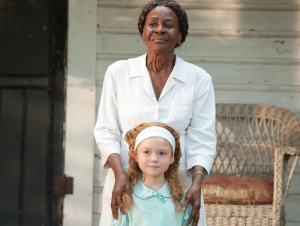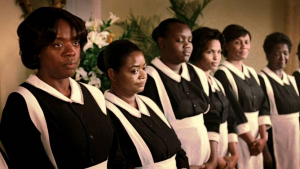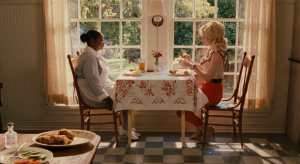60 The Help (2011)
Obstacles of Difference, Power, and Discrimination in The Help
By Sierra Borst
The Help is a film by Dreamworks Pictures and Reliance Entertainment and was released by Touchstone Pictures on August 09, 2011. The film takes place during the segregation and Jim Crow eras in the deep south of Jackson, Mississippi. The story goes through the life of Ms. Eugenia Skeeter, who returns from college to find that her beloved maid was not in her family’s home anymore. Not knowing where the woman who basically raised her was, the maid, and seeing how all of her high school “friends” treat theirs, she makes the decision to go against the law of Mississippi to tell the stories of the lives of maids in the homes of their employers. At the start of this journey she was only able to gain one maid’s approval, but after an incident that involved a fellow maid being beaten by police, more followed to have their voices heard. When you take a deeper look into the film you’ll find that, yes, the film displays all difference, power, and discrimination of African Americans, but, when you take a step back you can see this display in the real world, in both the film and the book that sparked the film. I believe that the film is an okay attempt at telling the story of the lives of maids in the 1960s, although it is not the best at being credible or accurate because the writer of the book as well as the producers of the film are all Caucasians.
To make this connection in the film to support my belief for how the film is not an accurate picture of the lives of these African American maids, I will be using not only characters within the film but also individuals who worked on the production of the film and the writer of the book who paved the way for it. The producers of the film and writer of the novel being Caucasians are excellent examples of how the “times” have changed, yes, but how much, how little? I will run through how the film uses a “white savior”, in the form of Eugenia Skeeter, to show how crucial it was to be Caucasian in the South, especially in Jackson, Mississippi. I will discuss the roles of the main two maids, Aibileen Clark and Minnie Jackson; Aibileen being the good, heartbroken individual with some bitterness from her time raising Caucasian children, at the expense of her own, while Minnie is a fired up and vengeful woman, who doesn’t want to show she is being beat down by her husband. The main villain, Hilly Holbrook, takes the form of a spoiled, manipulative, and conniving woman who not only runs her home with an iron fist, but also the town of Jackson.

Difference in the film can best be shown at an event to help “poor starving African American children in Africa”. You would think for a town that has so many laws and regulations against the rights of African Americans, wouldn’t want to help other or any African Americans at all, but no, in this they have a big party event, held by the malicious Hilly Holbrook herself. The event holds no remorse for its African American servants, the maids of every household, other than a “thank you to the help” remark by Hilly in the introduction of the event. The most prominent technique used in this scene is the use of lighting. The lighting differs from high-key to low-key lighting in between characters of Caucasians and African Americans, making it seem like the Caucasian individuals are better than the African Americans. In an event earlier on in the film, Hilly’s maid asked her to borrow $100 to finish off one of her two sons’ college costs, stating how she would work off the debt. Hilly remarked that it would be a loan and how she is simply not a bank. She tells the maid that it would not work out and how she was doing her a favor by not lending her the money because it wouldn’t be Christian-like to hand out money to people who could work for it. The way the producers portrayed these two scenes showed how they wanted the maids to be seen as charity cases. In the book, New Brutality Film: Race and Affect in Contemporary Hollywood Cinema, Paul Gormley states how Hollywood films portrayed African Americans for the sole purpose of “reanimating the affective impact of white Hollywood cinema by miming the power of African Americans.” This source shows how Hollywood has countlessly done this to impose a difference, even in the present, between Caucasians and African Americans.

Power, both in the film’s world and the real world while creating the film is relevant. The most obvious source of offscreen power goes to all three of the Caucasian male producers. Analyzing how our textbook, America On Film: Representing Race, Class Gender and Sexuality At The Movies, shows us how the Hollywood film Industry is “dominated” by Causcasian males, further shows how this film is also made by the majority about a specific “minority”. On-screen power can be shown not only by the main character, Skeeter by her being the only Caucasian woman who wants to speak up for the African American maids (along with African Americans all together), but also by Hilly. In the film, she holds a lot of power in the Jackson community, even in matters such as separate bathrooms in the Caucasian community specifically for their African American maids so they don’t catch any of their “diseases” (because we all know that diseases are only caught depending on the color of your skin). The best way the film shows the expression of power is in Hilly’s attire or “costumes”. Hilly is always dressed to impress throughout the film, besides one of the end scenes when the book by Skeeter, Ailbileen, and Minny was released. This shows that the producers wanted to show how crucial she was to the town of Jackson, how she was the role model for all Jackson women, of course, Caucasian Jackson women, and how she was the woman to be. In the movie review, “The Help: Film Review,” Kirk Honeycutt analyzes the power Hilly has on Jackson women, including her friends like Elizabeth Leefolt, Aibileen’s employer. He states that Aibileen is the example of “deferential politeness with a “ma’m” at the end of every utterance” but with a closer look or analysis you’ll find an individual “who suffers abuse at the hand of white employers” such as Elizabeth and Hilly themselves.

Over the course of the film, discrimination is both direct and indirect toward African American. The film is based in the 1960s which was consistently revolving around Jim Crow laws; the most famous one in the film being how Caucasian and African Americans can be “separate but equal” when this clearly was not close to the truth. This is a great example of how discrimination was indirect throughout the film because African Americans were still considered “equal” when separated, even though that wasn’t the reality. A way the film expresses direct discrimination toward African Americans is a scene with Aibileen when she is on her way home from work and is on the bus when something happens with the police involving an African American who had been shot. The bus is stopped and the driver demands that every colored person get off the bus, while the Caucasians are allowed to stay safe on the bus. Between these scenes the film technique used is mostly the sound, specifically of sirens, while you see Aibileen fearfully running toward her home, so afraid of what may happen she trips over herself in the process.
During casting, it is a possibility that there was discrimination. Considering that Hollywood has a background in this department I would not be surprised if there was, whether it be wanting a “specific type of African American” or considering blackface in the film (which has happened in movies as late as 2005). Although the film does try to portray the view “Yes, racism is vile and cruel, but hey, not all white people are bad” states Roger Ebert in his film review, The Help keep right on helping. In an encyclopedia article on segregation expert in Social Welfare History and Civil Rights David H. Jackson states how in Mississippi there were “a few blacks who participated in the political system during early Jim Crow years” but “they were still segregated within the party” and regularly “clashed with its lily-white counterpart(s)” showing how the phrase “separate but equal” was a virtue to the south instead of what it truly was, discrimination.
The book, Narratives of Women Who Worked as Maids During the Civil Rights Era (2012), by Katherine van Wormer, an expert in Social Welfare History and Civil Rights, provides a more accurate source based on true events and stories from women who were working as maids in the same time period as the film, The Help. The narrative, including gathering extensive information and having African American maids from the region of Mississippi get interviewed, took around a couple of years to complete. They collected about 40-50 interviews of women who were maids in Mississippi during the Jim Crow era. She explains how segregation was a continuance of a form of slavery; sharecropping replaced slavery in the fields while maids replaced servants in the home. Although they were allowed to quit, move away, or find nicer Caucasian employers. She states that their goal in writing this book was to “preserve the unique history of southern oppression and of how a race of people survived so that future generations will know and understand” which is exactly what the narrative achieves.
There are many reasons behind why I chose the film, The Help. For starters, I believed the film was notorious for all of the actors’ and actresses’ performances. They made you either root for or despise that specific character, and some prompted you to encourage them to change for the sake of themselves and their family. These can be seen through Skeeter’s mother especially, at first you think she is a bad person for firing her lovely maid of over 17 years only to impress the presence of “important” Caucasians, but, after reading Skeeters, Aibileen’s and Minny’s book she changes, and even stands up to Hilly’s racism and discrimination. I also thought that this film would be a perfect choice to analyze and discuss because I believe that similar things are happening in the present. These things that are happening can include many things, but at the very core, it’s still wrong and will be seen as wrong years or decades from now. But at the moment it is “socially acceptable”. There were a few films I was contemplating about doing but in the end, I believed that this was the right choice to bring attention to and analyze.
Though an inaccurate depiction of African American maids in the 1960s, on Hollywood’s part, they did provide tremendous acting performances. Even though the producers tried to portray the lives of these women and their emotions, they did not succeed. The viewpoint was in the perspective of Caucasian men, not African American maids (or even relatives of maids) in the Segregation and Jim Crow era. Overall, I think it proves that African American history, as well as culture, is being “white-washed” in our society today, causing their past to be practically erased from history. Although, this is happening to almost every culture, ethnicity, and race being either “white-washed”, used for media/promotion purposes and being exploited all while individuals still show hate about the same things they’re experiencing from other cultures.
REFERENCES
Ebert, Roger. “The Help Movie Review & Film Summary (2011): Roger Ebert.” The Help Movie Review & Film Summary (2011) | Roger Ebert, 9 Aug. 2011, www.rogerebert.com/reviews/the-help-2011
Gormley, Paul. The New-Brutality Film: Race and Affect in Contemporary Hollywood Cinema. Intellect, 2005. https://ebookcentral.proquest.com/lib/linnbenton-ebooks/reader.action?docID=282974
Honeycutt, Kirk. “’The Help’: Film Review.” The Hollywood Reporter, 10 Aug. 2018, www.hollywoodreporter.com/movies/movie-reviews/help-film-review-219915/
H. Jackson, David. “Segregation.” Mississippi Encyclopedia, Center for Study of Southern Culture, 15 Apr. 2018, https://mississippiencyclopedia.org/entries/segregation/
Wormer, Katherine Van, and July. “Maid Narratives.” Social Welfare History Project, 14 Mar. 2018, https://socialwelfare.library.vcu.edu/eras/maids-narratives/

